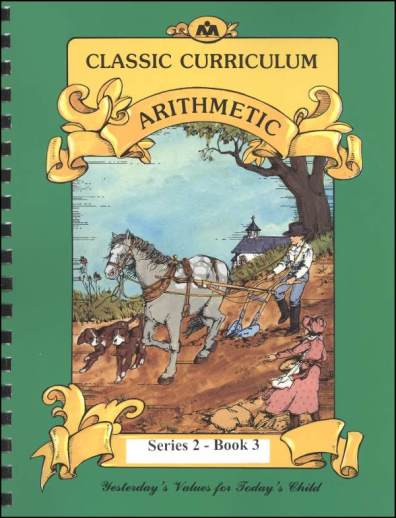We use cookies to make your experience better. To comply with the new e-Privacy directive, we need to ask for your consent to set the cookies. Learn more.
Classic Curriculum Arithmetic Series Series 2 Workbook 3
In America's one-room schoolhouses, Ray's Arithmetic was used alongside the McGuffey Readers. These are exact reproductions of the originals and their small size (4.5" x 7.25") cause one difficulty. They do not easily lay flat, making copying difficult. But the no-nonsense topic coverage provides old-fashioned competence so it is easy to understand why they are recommended by The Well-Trained Mind. Primary Arithmetic covers all four basic functions: addition, subtraction, multiplication, & division in single digits with word and money problems. New Intellectual Arithmetic reviews those four functions with multiple digits adding fractions and introducing ratio and percent. Practical Arithmetic continues the four functions along with fractions, decimals, percents, metrics, and introduces interest, discount, insurance, taxes, ration, proportions, square and cube roots, measurement, and progressions. Higher Arithmetic reviews the four functions and continues more advanced work in all the Practical Arithmetic topics including percentage applications with and without time. The Teachers Guide, designed to encourage teacher-student interaction, provides a scope and sequence as well as general information on math instructional stages (i.e. manipulatives, mental, abstract). There are also grade by grade teaching sequences along with a Planning Guide that shows a typical day and suggests weekly lesson plans as well as providing an assessment chart and test schedule. SC.~ Janice
Back in the 1800's children completed their Ray's Arithmetic work either orally or on chalkboards or personal slates. I'll bet these kids would have loved to have these babies. Series One workbooks teach the skills needed before beginning Ray's: writing, counting, combining sets, comparing numbers to 20. Series Two requires use of Ray's Primary Arithmetic and covers addition, subtraction, multiplication, and division through 9 along with time, measurement, and money problems. Series Three and Four requires Ray's Intellectual Arithmetic. Series Three continues work in learning the facts of the times and division tables, working word problems, fractions and mixed numbers. Series Four covers basic operations on integers and fractions, equivalent fractions, least common multiplier, and ratio. Throughout the series there is a continual emphasis on learning and reciting the fact tables as well as working story problems. Workbook pages are black and white with simple illustrations in the earlier books. Periodic reviews and quizzes and a test complete each book. Each series is designed to be used in a year with each book in the series being used in one quarter. Except for Series One, all answer keys are included. ~ Janice
| Product Format: | Softcover Book |
|---|---|
| Brand: | Mott Media |
| Author: | Dr. Rudy Moore |
| Grade: | 2 |
| ISBN: | 9780880622387 |
| Length in Inches: | 11 |
| Width in Inches: | 9 |
| Height in Inches: | 0.5 |
| Weight in Pounds: | 0.55 |

